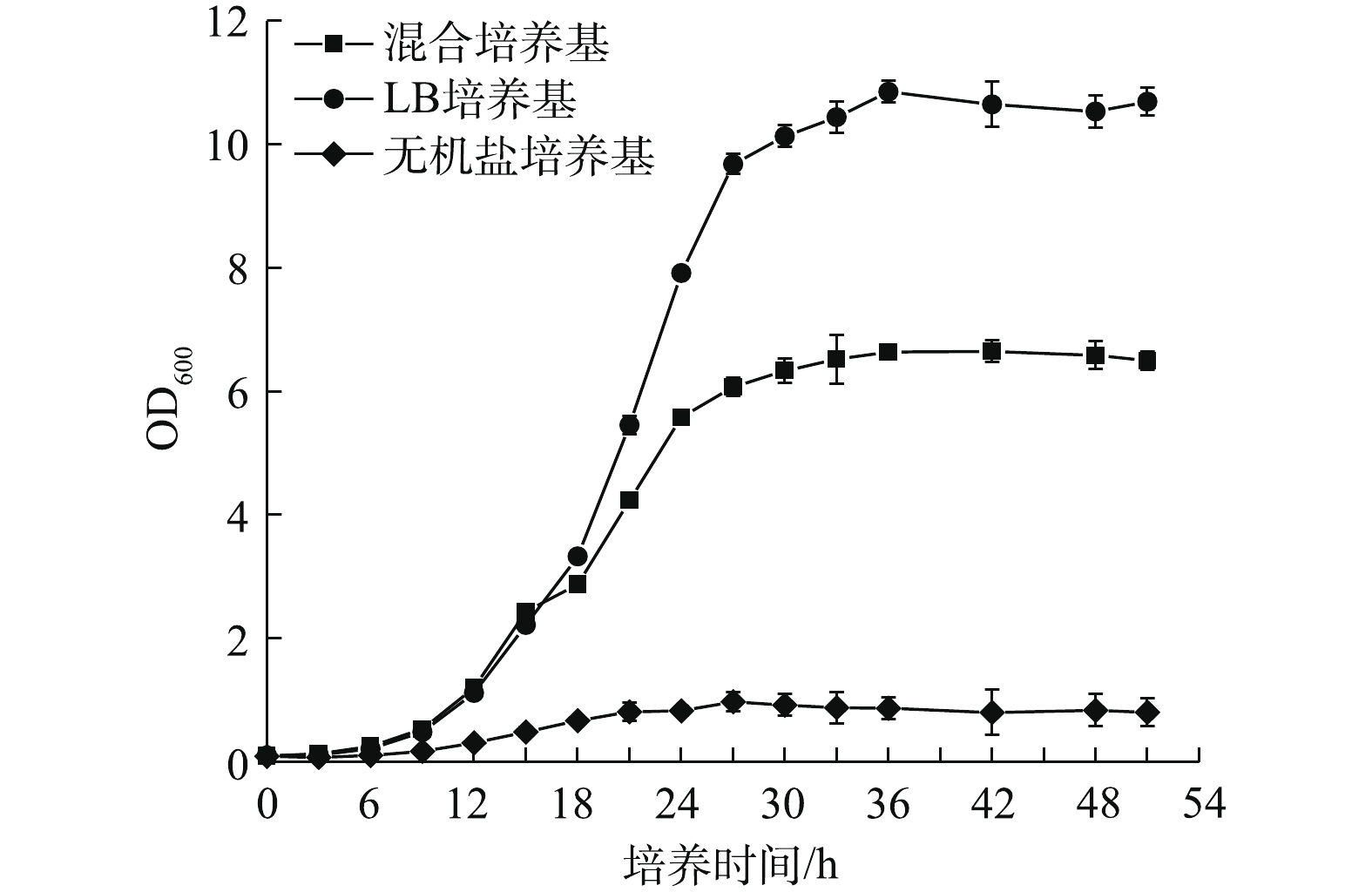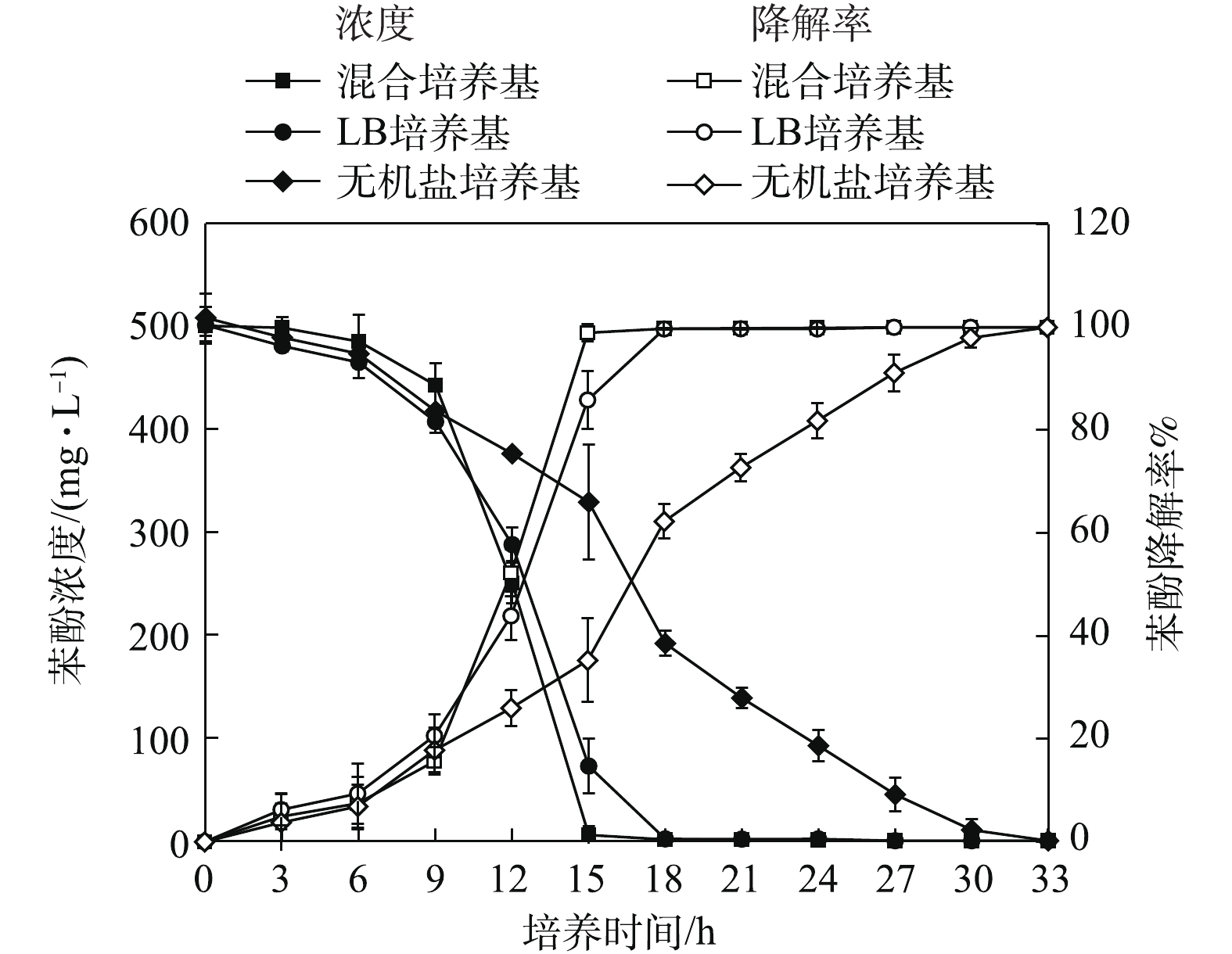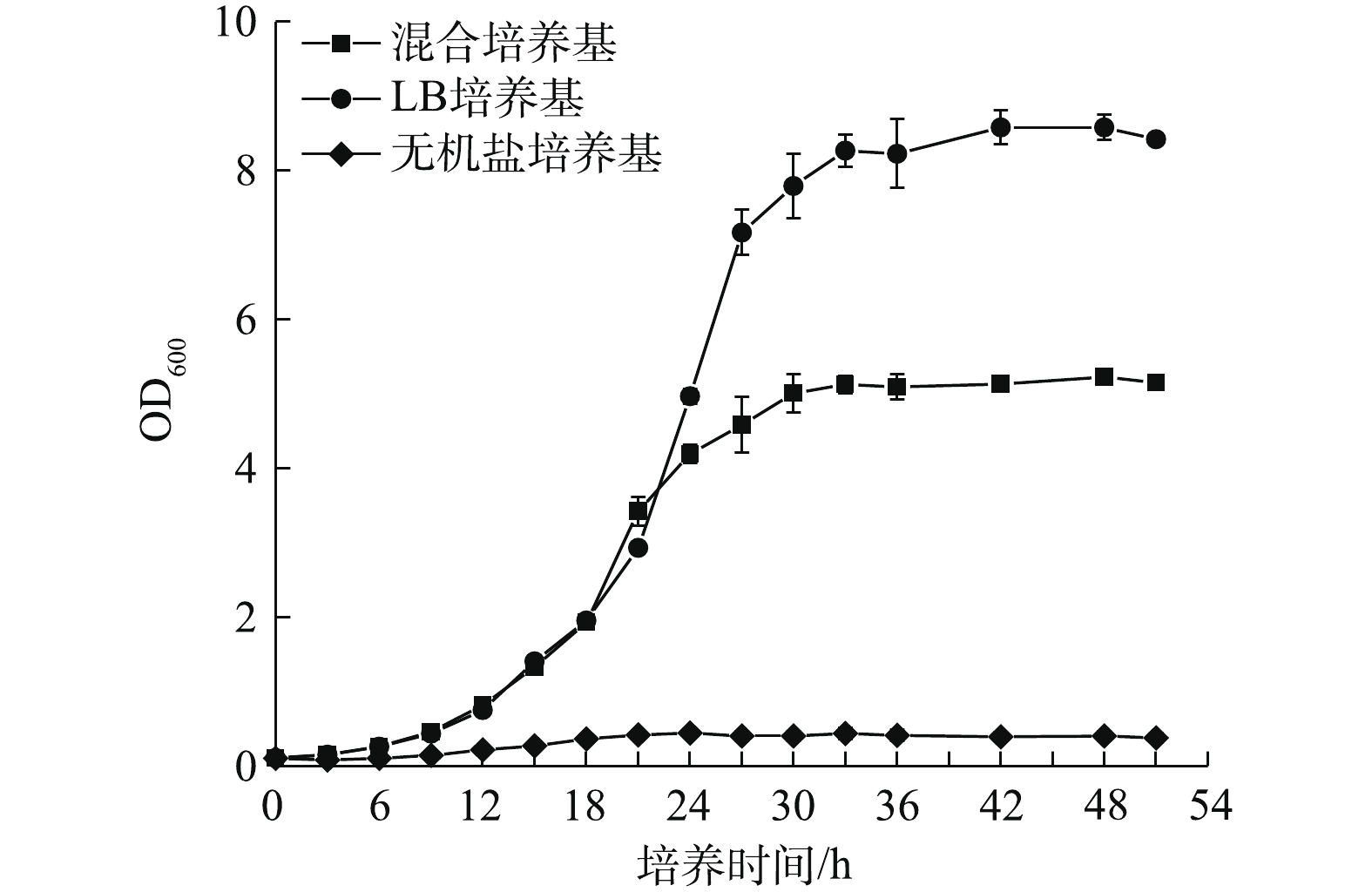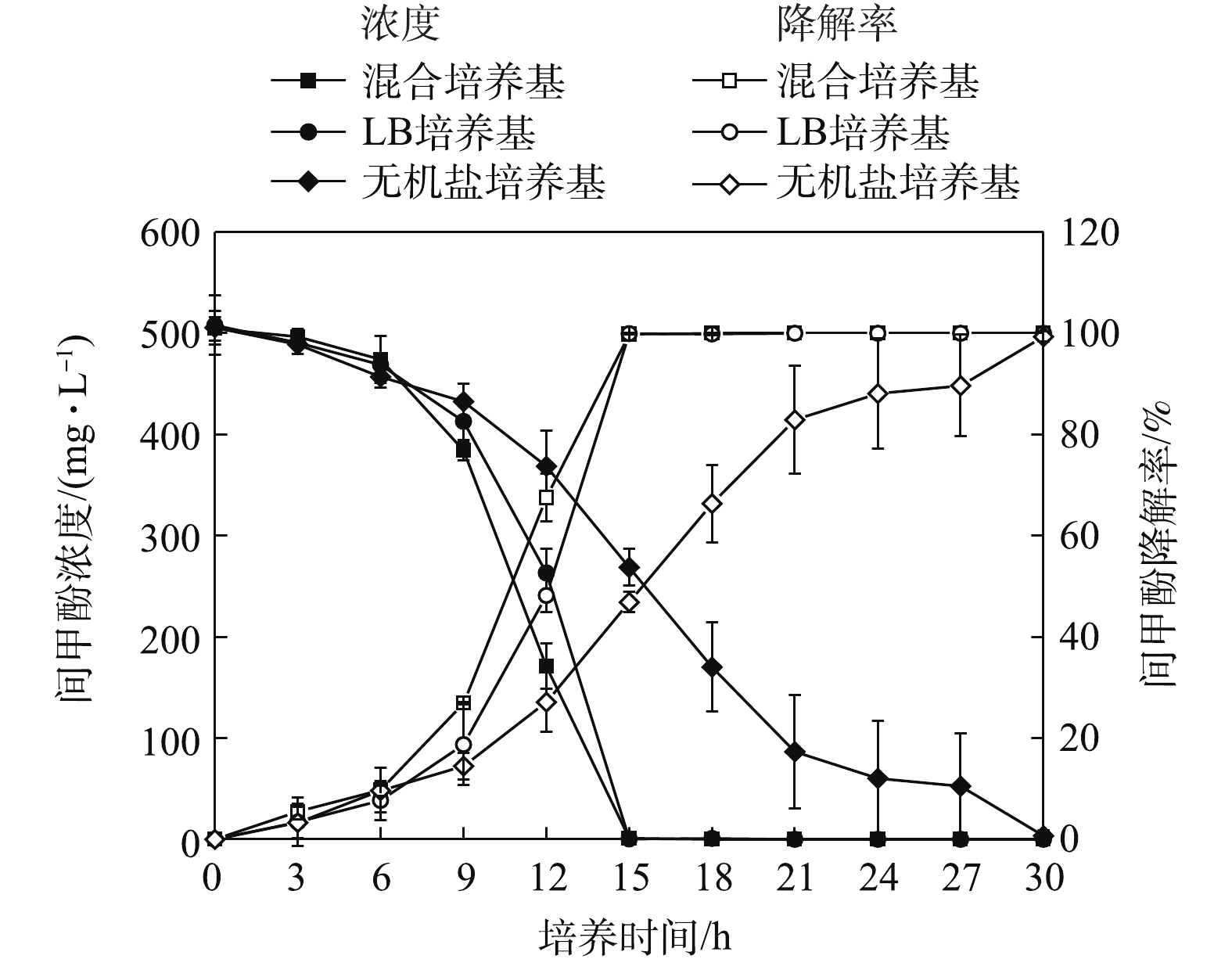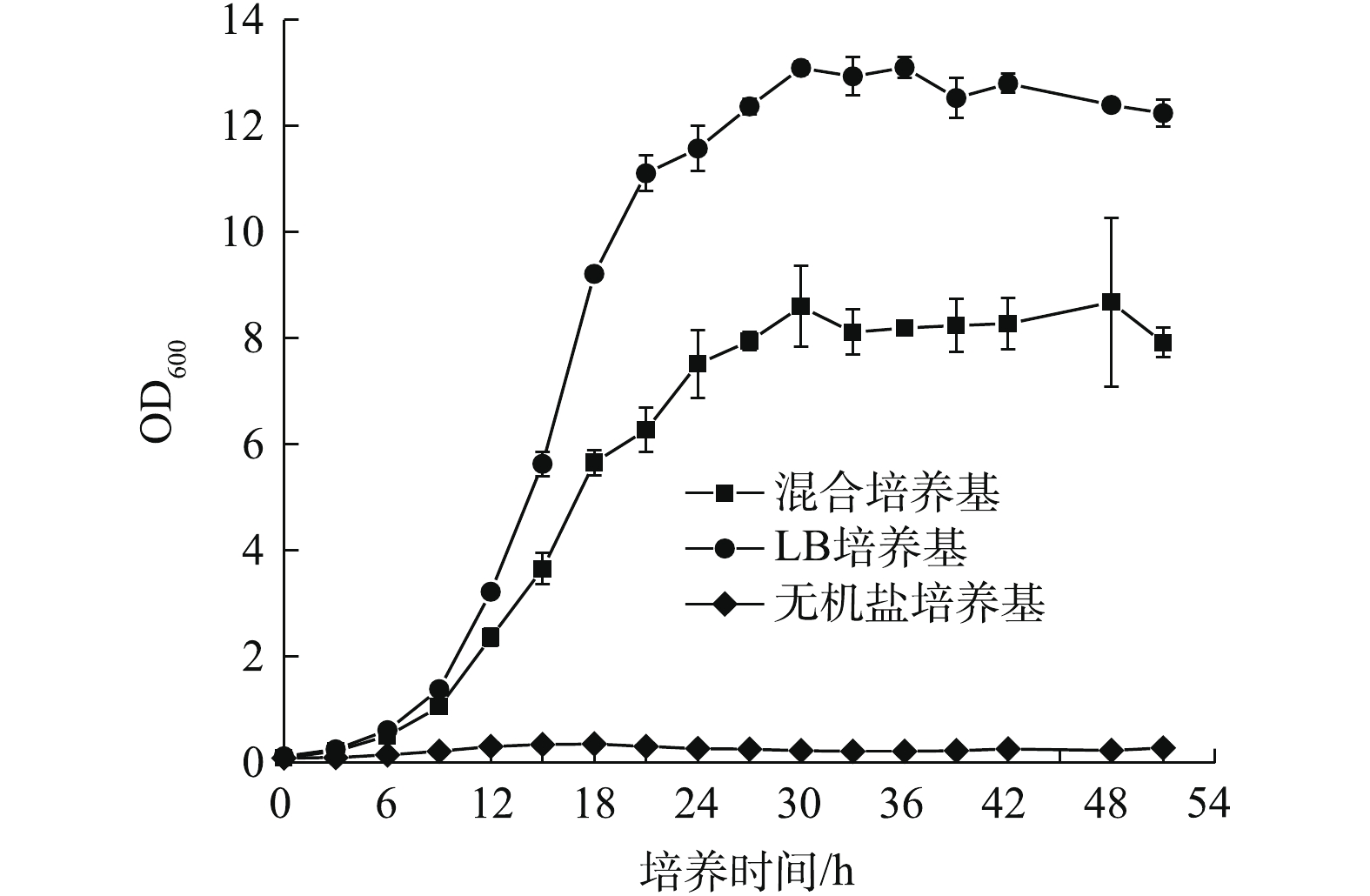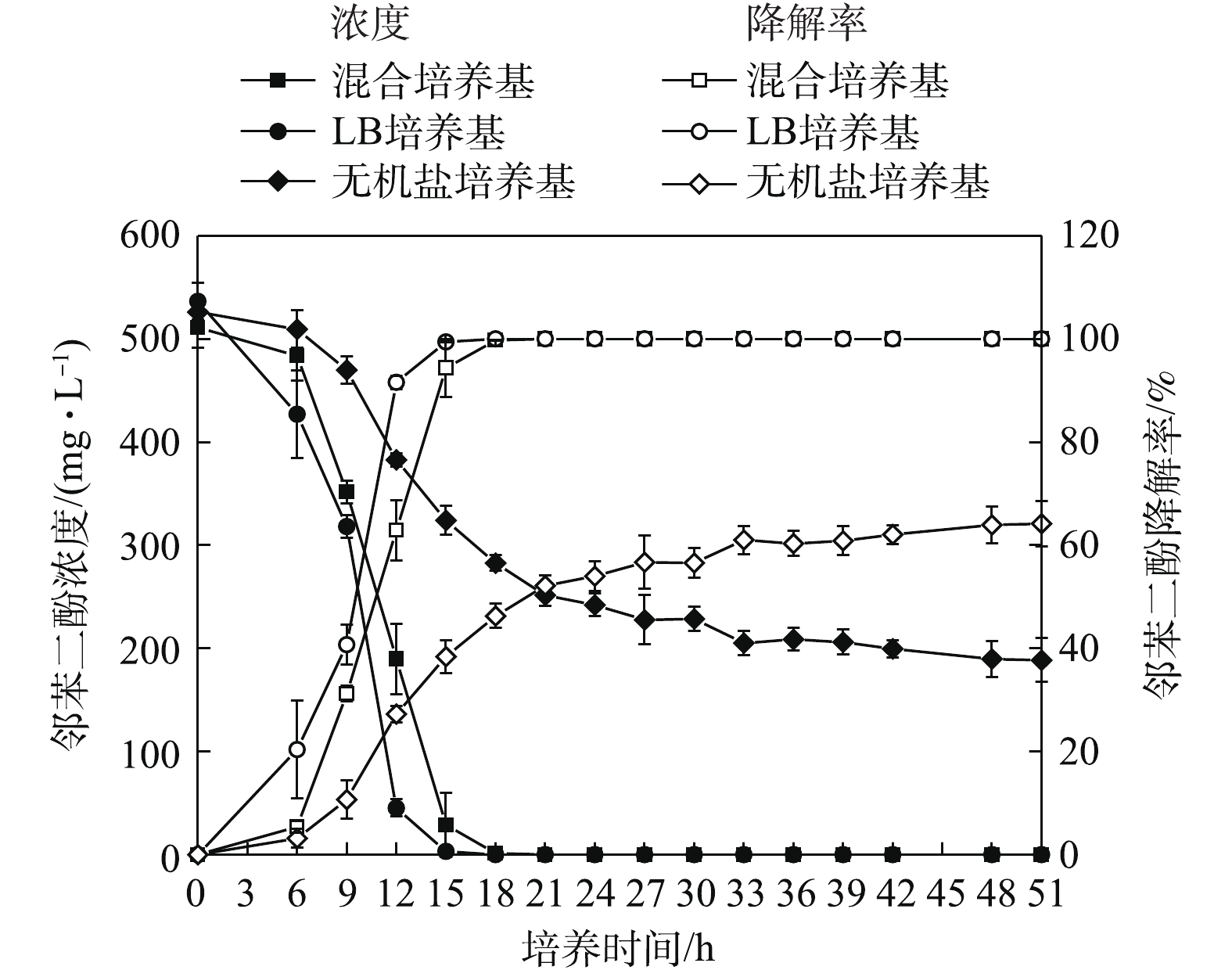-
酚类污染物是工业废水中常见的一类污染物,在石油精炼、塑料制造、树脂生产、农药生产、钢铁制造以及油漆生产等工业生产过程都有酚类污染物的产生[1]。酚类污染物的种类很多,其中以苯酚、甲酚、氯酚的污染最为突出[2]。由于苯酚及其衍生物有毒且难以降解,在水环境中分布广泛,已对生态环境造成损害,同时也严重威胁着人类的生存和发展,中国将苯酚、间甲酚、2, 4-二氯苯酚、2, 4, 6-三氯苯酚、五氯苯酚和对硝基苯酚列入环境优先处理的污染物“黑名单”[3]。因此,高效治理含酚废水的研究十分重要。
含酚废水的处理方法有很多,主要分为物理法、化学法和生物法。其中生物法因其成本低、二次污染小等优点而被广泛应用[4]。生物法处理含酚废水的关键在于降酚菌株的筛选[5]。据报道,国内外学者已从环境中成功分离、筛选出了一些降酚菌株。EREQAT等[6]从橄榄油废物中分离出1株苏云金芽孢杆菌(Bacillus thuringiensis),在96 h内对700 mg·L−1苯酚的最大去除率可达到88.6%;JIANG等[7]从工业废水处理系统中分离出1株德巴利氏酵母(Debaryomyces),在32 h内可完全降解500 mg·L−1苯酚;贾子龙[8]从焦化废水中分离出1株假单胞菌(Pseudomonas sp.),可在78 h内完全降解360 mg·L−1间甲酚;黄强等[9]筛选得到1株铜绿假单胞菌(Pseudomonas aeruginosa),其降解50 mg·L−1对硝基苯酚需要8 h;于彩虹等[10]从首钢焦化废水处理系统中分离出蜡状芽孢杆菌(Bacillus cereus),其完全降解400 mg·L−1和800 mg·L−1苯酚所需要的时间分别为24 h和72 h。这些菌株均能以单一酚为唯一碳源进行生长,但在有其他有机碳源存在时酚类物质降解的研究较少。酚类污染物种类繁多,寻求对酚类污染物具有降解广谱性,能够降解不同酚类物质的菌株对含酚废水的生物处理具有重要意义。同时,为了更好地研究降酚菌对酚类污染物的降解机理,降解动力学的研究是必不可少的[11]。微生物降解动力学有助于微生物处理的设计、运行合理化与科学化,克服长期以来微生物处理的设计和运行多为根据经验数据来进行的局限,为酚类污染物的生物处理提供理论依据[12]。
本研究报道了1株能以多种酚类污染物作为唯一碳源生长的红球菌对酚类污染物的耐受性,并针对其在耐受性强的3种酚中的生长情况结合降解特性进行了分析,发现该菌株在其他有机碳源存在时表现出更高的酚降解效率,这一特性更利于在酚类污染物土壤、水体治理中的实际应用。为阐明该菌株对苯酚、间甲酚、邻苯二酚3种酚类污染物的最适降解环境,根据菌株对3种酚的最小抑菌浓度,选择合适的浓度梯度建立动力学模型,为酚类污染物的治理提供技术基础。
全文HTML
-
实验用菌株为嗜联苯红球菌(Rhodococcus biphenylivorans),命名为B403,由湖北大学省部共建生物催化与酶工程国家重点实验室筛选,其保藏编号为CCTCC NO:M 2019087。
实验过程中所使用的培养基有3种类型:LB培养基、无机盐培养基、LB-无机盐混合培养基。LB培养基:胰蛋白胨10 g·L−1、酵母提取物5 g·L−1、NaCl 10 g·L−1。无机盐培养基:NaCl 0.2 g·L−1、KH2PO4 0.5 g·L−1、K2HPO4 0.5 g·L−1、NH4NO3 1 g·L−1、MgSO4·7H2O 0.2 g·L−1、FeSO4·7H2O微量。LB-无机盐混合培养基:胰蛋白胨5 g·L−1、酵母提取物2.5 g·L−1、NaCl 5.1 g·L−1、KH2PO4 0.25 g·L−1、K2HPO4 0.25 g·L−1、NH4NO3 0.5 g·L−1、MgSO4·7H2O 0.1 g·L−1、FeSO4·7H2O微量。
以上培养基调节pH至6.5~7.0,121 ℃蒸汽灭菌后30 min备用,每组设置3个平行,酚类污染物配成5 g·L−1母液,过滤除菌后,按需加入培养基中。
-
分别配制苯酚、间甲酚、对硝基苯酚、2, 4-二氯苯酚、2, 4, 6-三氯苯酚和邻苯二酚母液,设置苯酚浓度为1 100~1 200 mg·L−1、间甲酚浓度为600~700 mg·L−1、邻苯二酚浓度为600~700 mg·L−1、对硝基苯酚浓度为100~200 mg·L−1、2, 4-二氯苯酚浓度为0~100 mg·L−1、2, 4, 6-三氯苯酚浓度为0~80 mg·L−1。测定2, 4, 6-三氯苯酚时,每支试管浓度相差8 mg·L−1,测定其他酚类时,每支试管浓度相差10 mg·L−1。按0.6%的接种量接入菌株B403菌悬液,于28 ℃、200 r·min−1恒温摇床中培养24 h,肉眼观察,试管中溶液保持澄清时的最低浓度为最小抑菌浓度(MIC),通过最小抑菌浓度表征菌株对这6种酚的耐受性。
用LB液体培养基活化菌株B403单菌落,48 h后分别接种菌液至LB培养基、无机盐培养基、LB-无机盐混合培养基中培养,控制接种后培养基中初始OD600=0.1。在3种培养基中加入同一种酚,每个处理设置3个重复,于28 ℃、200 r·min−1恒温摇床中培养51 h,每3 h 取样1次,测定细菌生长量。同时取样1 mL培养液至EP管中,在12 000 r·min−1离心5 min后取上清液,用双蒸水稀释50倍,经0.22 μm的有机相微孔滤膜过滤,高效液相色谱法测定酚含量。苯酚、间甲酚、邻苯二酚初始浓度均设置为500 mg·L−1。
-
细菌生长量的测定:用空白培养基做参比,在波长600 nm下测定菌液的光吸收值,记作OD600,反映液体培养基中该菌株的生长状况。
苯酚含量的测定:采用高效液相色谱法[13],XDB-C18(5 μm,4.5 mm×150 mm)色谱柱,体积分数为50%的甲醇溶液为流动相,流速0.5 mL·min−1,柱温25 ℃,进样量10.00 μL,苯酚、间甲酚、邻苯二酚检测波长分别为270、272、270 nm。苯酚去除率按式(1)计算。
式中:
η 为苯酚去除率;C0为初始苯酚浓度,mg·L−1;C为反应后苯酚浓度,mg·L−1。
1.1. 实验原料
1.2. 实验方法
1.3. 分析方法
-
菌株B403在苯酚、间甲酚、邻苯二酚、对硝基酚、2, 4-二氯苯酚、2, 4, 6-三氯苯酚中的生长情况如表1所示。根据实验结果,菌株B403在实验浓度范围内的6种酚中均能生长,但对酚的耐受能力存在差异。菌株B403对苯酚的耐受能力最强,最小抑菌浓度为1 190 mg·L−1;其次是间甲酚和邻苯二酚,最小抑菌浓度分别为630 mg·L−1和700 mg·L−1。该菌对硝基苯酚、2, 4-二氯苯酚、2, 4, 6-三氯苯酚的最小抑菌浓度分别为140、70、48 mg·L−1,说明这3种酚对菌株B403的生长抑制较为强烈,可能与这3种酚中含有的硝基和卤原子取代基有关[14]。在耐受性实验基础上,选取耐受能力较强的苯酚、间甲酚和邻苯二酚考察菌株在不同碳源条件下的生长和降酚特性。
-
在分析菌株B403在苯酚中的生长情况和降解效率时,以500 mg·L−1苯酚为底物,初始接种OD600一致,测定菌株B403生长量和苯酚含量。菌株B403在苯酚-无机盐培养基、苯酚-LB培养基及苯酚-LB-无机盐混合培养基中的生长曲线和对苯酚的降解曲线如图1和图2所示。3种培养基中菌株B403表现出不同的生长特性,在苯酚-LB培养基中,菌株B403的生长状况最佳,在51 h内,OD600最大可增加至10.85。在苯酚-LB-无机盐混合培养基生长状况次之,51 h内,OD600最高值为6.65。而在苯酚-无机盐培养基中,菌株B403的生长状况最差,在51 h内,OD600最大值仅为0.97。这说明该菌能够以苯酚为唯一碳源生长,且在有其他有机碳源存在的情况下能快速提高菌株的生物量。苯酚-LB培养基和苯酚-LB-无机盐混合培养基的菌株在前15 h内生长情况基本一致。18 h后,菌株B403在苯酚-LB培养基和苯酚-LB-无机盐混合培养基中的生长明显加快,相比在无机盐培养基中差异更为明显。这说明在生长前期,苯酚对菌株B403生长有一定的抑制作用,这种抑制作用在苯酚作为单一碳源时更为显著。在含有其他有机碳源的条件下,18 h之后,苯酚对菌株的生长抑制减弱,菌株快速进入对数期,而苯酚为唯一碳源条件下,苯酚对菌株的生长抑制并没有随着时间的增加而减弱。
菌株B403在不同培养基中酚降解效率存在明显差异,15 h时,苯酚-LB-无机盐混合培养基中菌株B403对苯酚的降解率最高,达到了98.92%,在苯酚-LB培养基中的苯酚降解率为85.87%。处理18 h后,2种培养基中的苯酚被完全降解,而苯酚-无机盐培养基中的菌株酚降解效率仅为62.27%,处理30 h能达到97.85%,菌株B403在苯酚-无机盐培养基中的降解效率最低与其低生物量密切相关[15]。添加有机碳源不仅能够增强该菌株对酚的耐受性,而且提高了生物酚降解效率[16-17]。在实验过程中发现,在苯酚降解过程中会产生邻苯二酚和顺, 顺-黏糠酸等中间产物,但这些中间产物量非常小,与已报道的结果[18-19]一致。低浓度邻苯二酚和顺, 顺-黏糠酸等中间产物对菌株生物生长抑制较弱,因此,推测在菌株B403生物降解苯酚的过程中主要抑制物为苯酚。18 h后,在苯酚-LB培养基和苯酚-LB-无机盐混合培养基中的苯酚完全被降解,此时菌株B403利用其他有机碳源继续生长,生长速率大幅度提升。菌株B403在苯酚-LB-无机盐混合培养基的降解效率高于在苯酚-LB培养基中的降解效率,这说明在含有较高生物量的情况下,添加少量的无机盐离子对该菌株降解苯酚有促进作用。
关于苯酚的微生物降解已经有了大量的研究,陈晓华等[20]筛选了1株苍白杆菌(Ochrobactrum sp.),在30 ℃、初始pH=7.0、接种量为5%、初始苯酚浓度为400 mg·L−1的条件下,完全降解苯酚需要24 h;沈娥等[21]分离了1株红球菌W2,在30 ℃、pH=7.0、50 g·L−1NaCl 条件下,其降解500 mg·L−1苯酚需要78 h;高振贤等[22]发现Ralstonia metallidurans CH34菌株降解4 mmoL·L−1苯酚需要48 h。菌株B403在苯酚为唯一碳源的条件下,其降解苯酚能力明显高于以上文献报道中的菌株。在此基础上,添加常规碳源可大幅提高该菌株的苯酚降解能力,含酚工业废水以及土壤中往往含有丰富的常规碳源,这一特性更利于菌株B403在环境领域实际应用。
在分析菌株B403在间甲酚中的生长情况和降解效率时,以500 mg·L−1间甲酚为底物,其他条件同上,绘制生长曲线和降解曲线,如图3和图4所示。结果表明,在间甲酚-LB培养基中,在51 h内,OD600最大增加到8.58,菌株B403的生长状况最佳。在间甲酚-LB-无机盐混合培养基中,生长状况次之,51 h内,最高增长到5.23。而在间甲酚-无机盐培养基中,菌株B403的生长状况最差,在51 h内,OD600最大仅增长到0.44。这说明该菌不仅能以苯酚为唯一碳源生长,而且在间甲酚为唯一碳源时也能生长。当间甲酚为唯一碳源时,间甲酚及其代谢中间产物对菌株生长均有持续抑制作用,因而菌株生物量较低,而在有其他有机碳源存在时,18 h后间甲酚及其代谢中间产物对菌株的生长抑制作用减弱,导致菌株生物量大幅度提高。彭丽花等[23]发现,Citrobacter farmeri sp.在间甲酚完全降解的反应液中,中间产物所带来的TOC占总TOC的25%左右,间甲酚中间产物的进一步转化反应可能受到某种条件的制约。菌株B403在含苯酚的3种培养基中的生物量高于含同浓度间甲酚的3种培养基中的生物量可能与此相关。
菌株B403在不同培养基中对间甲酚的降解效率存在明显差异。在12 h时,间甲酚-LB-无机盐混合培养基中菌株B403对间甲酚的降解率达到67.49%,15 h间甲酚被完全降解;间甲酚-LB培养基中在12 h时对间甲酚降解率为48.17%,15 h达到99.93%,18 h间甲酚被完全降解;而在18 h时,甲酚-无机盐培养基中的菌株对间甲酚的降解率仅为66.34%,30 h后,间甲酚被完全降解。间甲酚-LB培养基和间甲酚-LB-无机盐混合培养基中的间甲酚完全降解后,菌株B403可以利用其他有机碳源继续生长,生长速率大幅度提升。菌株B403在间甲酚-LB-无机盐混合培养基的降解效率高于在间甲酚-LB培养基中的降解效率,说明在含有较高生物量的情况下,添加适量无机盐离子对该菌降解间甲酚有一定的促进作用。菌株B403在间甲酚-LB培养基和间甲酚-LB-无机盐混合培养基中的高生物量和比生长速率大幅度地提升了其对间甲酚的降解效率。葛启隆[24]发现1株短芽孢杆菌(Brevibacillus borstelensis),在添加200 mg·L−1琥珀酸后,降解300 mg·L−1间甲酚所需时间缩短了20 h,这与上述文献结果相符。
白静[25]得到1株降酚菌Alcaligenes faecalis sp.,其对间甲酚最大降解能力为250 mg·L−1,需要118 h才能降解完全。WANG等[26]利用Paecilomyces variotii JH6降解300 mg·L−1间甲酚,在65 h时,间甲酚去除率达到96.4%。通过实验对比发现,菌株B403具有更高的间甲酚降解能力。
在分析菌株B403在邻苯二酚中的生长情况和降解效率时,以500 mg·L−1邻苯二酚为底物,其生长和降解特性如图5和图6所示。与苯酚、间甲酚结果类似,在邻苯二酚-LB培养基中,菌株B403的生长状况最佳,在51 h内,OD600最大值为13.09;其次是邻苯二酚-LB-无机盐混合培养基,在51 h内,OD600最高增长为8.68;而在邻苯二酚-无机盐培养基中,菌株B403的生长状况最差,在51 h内,OD600最大仅增长到0.36。这说明菌株能够以邻苯二酚为唯一碳源进行代谢生长,并且有外加碳源存在时,对菌株生物量有大幅提高。邻苯二酚-LB培养基和邻苯二酚-LB-无机盐混合培养基的菌株在前6 h内生长速率基本一致。9 h后,生长速率均有了明显提升,这说明其他有机碳源能够减弱邻苯二酚对菌株的生长抑制,菌株进入对数生长期,与苯酚和间甲酚生长情况相比,菌株进入对数期时间更短,且在18 h后菌株进入衰亡期,这说明邻苯二酚对菌株具有持续的生长抑制。
菌株B403在不同培养基中对邻苯二酚的降解效率也存在明显差异。邻苯二酚-LB培养基中菌株完全降解邻苯二酚仅需15 h,邻苯二酚-LB-无机盐混合培养基中18 h后完全降解,此时邻苯二酚-无机盐培养基中菌株对邻苯二酚的降解率仅为46.27%。该菌株在无机盐培养基中对邻苯二酚的降解效率最差,在51 h时,仍然没有完全降解,降解率为64.16%。邻苯二酚是苯酚降解的中间产物[27],邻苯二酚既可以促进微生物生长,同时也可能具有生物毒害作用抑制微生物生长[28]。邓维琴等[29]确定了1株鞘氨醇单胞菌(Sphingomonas sp. SC-1),其能在48 h降解100 mg·L−1邻苯二酚。程珂珂等[30]发现了1株邻苯二酚降解菌,当邻苯二酚浓度超过400 mg·L−1时,菌株生长会受到明显抑制,邻苯二酚降解率仅能达到45%。当无机盐培养基中含有高浓度邻苯二酚时,菌株B403生长受到了明显抑制,菌株快速进入衰亡期,邻苯二酚无法完全降解,说明高浓度邻苯二酚对菌株有较强抑制作用。在邻苯二酚-LB培养基和邻苯二酚-LB-无机盐混合培养基中,菌株B403能够正常生长,邻苯二酚降解效率也有所提高,表明其他有机碳源的存在可以缓解邻苯二酚对菌株B403的抑制作用。与苯酚、间甲酚底物情况不同,菌株B403在LB培养基中对邻苯二酚的降解效率最佳,这说明无机盐离子的存在对菌株降解邻苯二酚没有促进作用。
实验结果表明,菌株B403的降解底物具有广谱性,在好氧条件下不仅能够将苯酚作为碳源进行生长和降解苯酚,还能在一定浓度范围内降解间甲酚和邻苯二酚。菌株B403的生长与苯酚降解同步进行,分别以3种酚为唯一碳源时,苯酚和间甲酚对菌株B403生长抑制程度相近,邻苯二酚对菌株生长抑制作用更强。在有其他有机碳源存在时,3种酚对菌株的生长抑制均有缓解,菌株生物量大幅增长,极大地促进了菌株对3种酚的降解。此外,无机盐离子对苯酚和间甲酚的降解也有一定促进作用,而对邻苯二酚的降解没有起到促进作用。
-
国内外已有一系列酚类降解动力学模型[31],对于酚类底物既是反应基质又是抑制剂的生物降解过程,通常采用Haldane方程来模拟底物降解动力学过程[32]。分别以500 mg·L−1苯酚、邻苯二酚、间甲酚作为底物,降解速率最高的培养基为实验用培养基,苯酚和间甲酚采用LB-无机盐混合培养基,邻苯二酚采用LB培养基,进行降解动力学实验。根据最小抑菌浓度设置浓度梯度,投加菌株B403后,在不同降解时间下测定培养液中3种酚的浓度,对实验数据进行拟合并求出Haldane方程参数。Haldane方程如式(2)所示。
式中:q为比底物利用速率,h−1;qm为最大比底物利用速率,h−1;S0为初始底物浓度,mg·L−1;Ks为底物亲和常数,mg·L−1;KI为底物抑制常数,mg·L−1。
将实验结果在matlab 7.0中进行非线性回归分析,得到所有分离物的动力学参数qm、Ks、KI,如表2所示。可以看出,苯酚、间甲酚、邻苯二酚的降解动力学均符合Haldane方程,拟合情况良好。图7为菌株B403降解3种酚的降解曲线。图7(a)为苯酚降解曲线,完全降解200、400、600、800、1 000、1 200 mg·L−1苯酚所需时间分别为12、15、18、24、30、45 h;图7(b)为间甲酚降解曲线,完全降解100、200、300、400、500、600 mg·L−1间甲酚所需时间分别为9、9、12、15、18、21 h;图7(c)为邻苯二酚降解曲线,完全降解100、200、300、400、500、600 mg·L−1邻苯二酚所需时间分别为9、12、12、15、18、21 h。根据3种酚的降解曲线可知,菌株B403降解酚类污染物的滞后期随着浓度的升高明显延长,不同初始浓度具有相同降解率可能与取样时间间隔有关。
图8为菌株B403对3种酚的降解速率曲线和拟合降解曲线。当苯酚、间甲酚、邻苯二酚浓度分别超过136.4、87.4、116.1 mg·L−1时,菌株B403对3种酚的比降解速率随着浓度的升高而降低,呈现底物抑制作用,即认为136.4、87.4、116.1 mg·L−1分别为降解苯酚、间甲酚、邻苯二酚的最佳浓度。在降解动力学方程中,若底物抑制常数(KI)越大,说明菌株对底物的抑制越不敏感,底物亲和常数(Ks)越大,说明菌株对底物生物降解的潜能越大,最大比底物利用速率(qm)越大,则表明底物越容易被降解,误差平方和越接近0,R2越接近1,这说明模型拟合得越好。菌株B403对苯酚的KI最大,为69 mg·L−1,这说明实验的3种酚中菌株B403对苯酚的抑制最不敏感,与实验中菌株对苯酚具有最高的最小抑菌浓度的实验结果一致。菌株B403对邻苯二酚的Ks和qm最大,邻苯二酚作为苯酚的代谢产物,在有其他有机碳源存在时,邻苯二酚更容易被菌株利用,菌株对邻苯二酚的生物降解潜能最大。由误差平方和和R2可知,使用Haldane模型拟合苯酚、邻苯二酚、间甲酚的降解动力学过程时,间甲酚的拟合效果最佳。
张玉秀等[33]从焦化废水中分离出1株苯酚降解菌红球菌(Rhodococcus sp.),并用Haldane方程对其降解苯酚的实验数值进行拟合,得到降解苯酚的最佳浓度为234.548 mg·L−1,Ks=77.487 mg·L−1。贾子龙[8]从处理模拟焦化废水系统里分离得到1株假单胞菌(Pseudomonas sp.),用Haldane方程对其降解间甲酚进行拟合,得到降解间甲酚的最佳浓度为40 mg·L−1,Ks=9.85 mg·L−1。目前关于菌株降解邻苯二酚的降解动力学研究较少,相比于其他研究,菌株B403降解苯酚的最佳浓度较低,Ks高于大部分已报道的菌株,这说明菌株B403对多种酚类污染物生物降解的潜能较大。
2.1. 菌株B403对不同酚类污染物的耐受性
2.2. 不同碳源条件下菌株B403在酚类污染物中的生长和降解情况
2.3. 菌株B403降解酚类污染物的动力学
-
1)菌株B403对苯酚、间甲酚、邻苯二酚、对硝基苯酚、2, 4-二氯苯酚和2, 4, 6-三氯苯酚的最小抑菌浓度分别为1 190、630、700、140、70、48 mg·L−1;菌株B403对苯酚、间甲酚、邻苯二酚有较强的耐受性。
2)菌株B403在含有500 mg·L−1的单一酚(苯酚、间甲酚、邻苯二酚)的LB培养基和LB-无机盐混合培养基中与在含有500 mg·L−1的单一酚(苯酚、间甲酚、邻苯二酚)的无机盐培养基中与相比,生物量和降酚能力大幅提高,其他有机碳源的存在,更有利于菌株B403生长,提高降酚能力,具有广阔的应用前景。
3)菌株B403在含常规碳源条件下降解苯酚、间甲酚、邻苯二酚均符合Haldane模型。降解苯酚、间甲酚、邻苯二酚的最佳浓度分别为136.4、87.4、116.1 mg·L−1,菌株B403对3种酚的生物降解潜能较大。



 DownLoad:
DownLoad:
